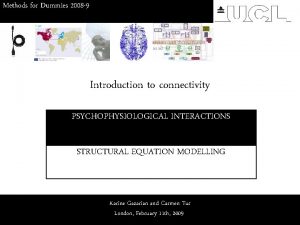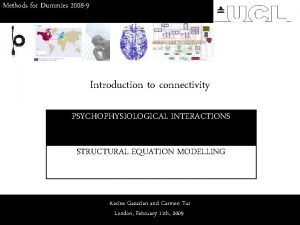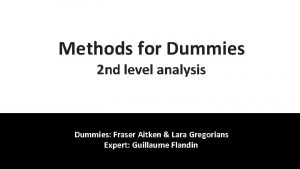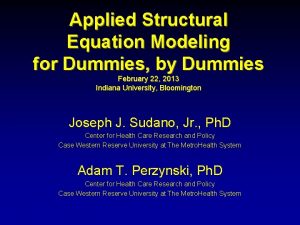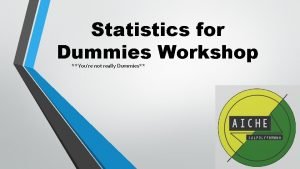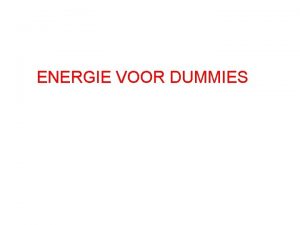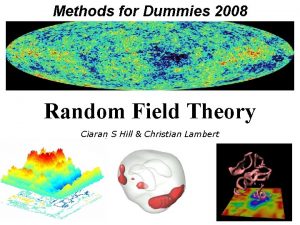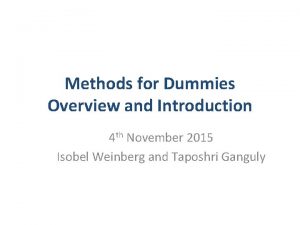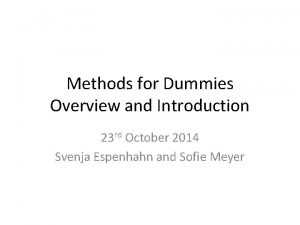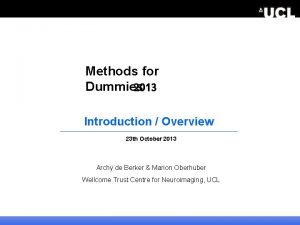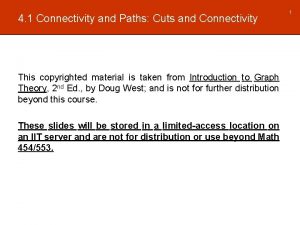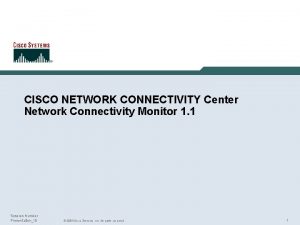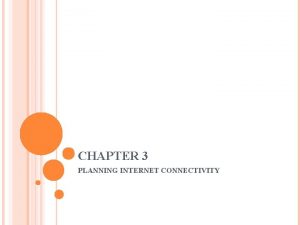Methods for Dummies 2008 9 Introduction to connectivity






































- Slides: 38

Methods for Dummies 2008 -9 Introduction to connectivity PSYCHOPHYSIOLOGICAL INTERACTIONS STRUCTURAL EQUATION MODELLING Karine Gazarian and Carmen Tur London, February 11 th, 2009

Index 0. Preface I. Origins of connectivity II. Different approaches of connectivity a. Functional connectivity b. Effective connectivity III. Interactions a. b. Factorial design Psychophysiological interactions IV. Structural Equation Modelling V. Conclusions

Preface Physicist Level of the Talk ? Clinician Wish of doing a talk about connectivity

I. Origins of connectivity Functional localization Gall – 19 th century A certain function was localised in a certain anatomic region in the cortex Functional segregation A certain function was carried out by certain areas/cells in the cortex but they could be anatomically separated Functional specialization Specialised areas exist in the cortex “Connectionism” Goltz – 19 th century Critizied Gall’s theory of functional localization Evidence provided by dysconnection syndromes Functional integration Networks: Interactions among specialised areas

II. Different approaches to connectivity Functional segregation Functional integration Networks Connectivity Functional connectivity No model-based Simple correlations between areas Its study allows us to speak about temporal correlations among activation of different anatomic areas These correlations do not reflect teleologically meaningful interactions Effective connectivity Model-based It allows us to speak about the influence that one neuronal system exerts over another It attempts to disambiguate correlations of a spurious sort from those mediated by direct or indirect neuronal interactions

II. Different approaches of connectivity – Functional connectivity stimulus Region i Region k Time βik ~ Functional connectivity What? Relationship between the activity of 2 different areas How? Principle Component Analysis (PCA), which is done by Singular Value Decomposition (SVD) eigenvariates and eigenvalues obtained Why? To summarise patterns of correlations among brain systems Find those spatio-temporal patterns of activity which explain most of the variance in a series of repeated measurements.

II. Different approaches of connectivity – Effective connectivity stimulus Region i Region k A known pathway is tested Time xkβik ~ Effective connectivity What? Real amount of contribution of one area (contribution of the activity of one area) to another. How? It takes into account functional connectivity (correlations between areas), the whole activation in one region and interactions between different factors Types of analysis to assess effective connectivity: 1. PPI – psychophysiological interactions STATIC MODELS 2. SEM – structural equation modeling 3. DCM – dynamic causal model DYNAMIC MODEL

III. Interactions a. FACTORIAL DESIGN Study design where two or more factors are involved within a task Aim: to look at the interaction between these factors to look at the effect that one factor has on the responses due to another

III. Interactions a. FACTORIAL DESIGN An example: Investigation of interaction between motor activation and time (Friston et al. 1992)

III. Interactions a. FACTORIAL DESIGN TYPES OF INTERACTIONS PSYCHOLOGICAL BOLD signal Cognitive task Distracting task PHYSIOLOGICAL PP V 5 PFC During the memory task PSYCHOPHYSIOLOGICAL V 5 V 2 Psychological context Attention – No attention

III. Interactions a. FACTORIAL DESIGN An example: Dual-task interference paradigms (Fletcher et al. 1995)

III. Interactions – b. PSYCHOPHYSIOLOGICAL INTERACTIONS Studies where we try to explain the physiological response in one part of the brain in terms of an interaction between prevalence of a sensorimotor or cognitive process and activity in another part of the brain An example: interaction between activity in region V 1 and some psychological parameter (e. g. attention vs no attention) in explaining the variation in activity in region V 5 V 2 Psychological context Attention – No attention Buchel and Friston Cerebral cortex 1997

III. Interactions – b. PSYCHOPHYSIOLOGICAL INTERACTIONS Attention Activation in region i (e. g. V 5 activity) ? No attention Activation in region k (e. g. V 2 activity) Here the interaction can be seen as a significant difference in the regression slopes of V 5 activity on V 2 activity when assessed under two attentional conditions

III. Interactions – b. PSYCHOPHYSIOLOGICAL INTERACTIONS Two possible perspectives on this interaction… We could have that V 5 activity/response reflects: A change of the contribution from V 2 by attention A modulation of attentionspecific responses by V 2 inputs

III. Interactions – b. PSYCHOPHYSIOLOGICAL INTERACTIONS H 0: b 1 is = 0 Mathematical explanation H 1: b 1 is ≠ 0 and p value is y = b 1*(x 1 X x 2) + b 2*x 1 + b 3*x 2 + e < 0. 05 V 2 V 5 Interaction term Psychological context Attention – No attention Physiological activity in V 5 We want to test H 0 Interaction between activity in V 2 and psychological context

III. Interactions – b. PSYCHOPHYSIOLOGICAL INTERACTIONS Neurobiological process: Where these interactions occur? Hemodynamic vs neural level Hemodynamic responses – BOLD signal – reflect the underlying neural activity HRF basic function But interactions occur at a NEURAL LEVEL And we know: (HRFx. V 2) X (HRFx. Att) ≠ HRFx(V 2 XAtt) ≠ Gitelman et al. Neuroimage 2003 ?

III. Interactions – b. PSYCHOPHYSIOLOGICAL INTERACTIONS Neurobiological process: Where these interactions occur? Hemodynamic vs neural level SOLUTION: 1 - Deconvolve BOLD signal corresponding to region of interest (e. g. V 2) BOLD signal in V 2 Neural activity in V 2 Psychological variable x 2 - Calculate interaction term considering neural activity psychological condition x neural activity HRF basic function 3 - Re-convolve the interaction term using HRF Gitelman et al. Neuroimage 2003

III. Interactions – b. PSYCHOPHYSIOLOGICAL INTERACTIONS How can we do this in SPM? Practical example from SPM central page We want to assess whether the influence that V 2 exerts over other areas from visual cortex (V 5) depends on the status of a certain psychological condition (presence vs. absence of attention) No Att V 2 V 5 Attention – No attention http: //www. fil. ion. ucl. ac. uk/spm/data/attention/

III. Interactions – b. PSYCHOPHYSIOLOGICAL INTERACTIONS How can we do this in SPM? I. GLM analysis 1. Estimate GLM Y = X . β + ε

III. Interactions – b. PSYCHOPHYSIOLOGICAL INTERACTIONS How can we do this in SPM? I. GLM analysis 2. Extract time series Meaning? To summarise the evolution in time and space of the activation of a certain region Place? At region of interest (e. g. V 2) region used as explanatory variable Procedure? Principle Component Analysis (done by Singular Value Decomposition) To find those spatio-temporal patterns of activity which explain most of the variance of our dataset (i. e. activity in V 1 over time) these patterns are represented by the eigenvectors the variance of these eigenvectors is represented by eigenvalues Reason? To include (the most important) eigenvalues in the model we transform dynamic information (movement in time & space) into STATIC information (saved as a new matrix) we will work with this static information PPI is a STATIC MODEL

III. Interactions – b. PSYCHOPHYSIOLOGICAL INTERACTIONS How can we do this in SPM? I. GLM analysis 2. Extract time series Y = X. β + ε + C. V 2. β V 2 activity y y x z z z x x Time We add information about spatio-temporal patterns of activity which best explains our data into the previous model

III. Interactions – b. PSYCHOPHYSIOLOGICAL INTERACTIONS How can we do this in SPM? II. PPI analysis 1. Select (from the previous equation-matrix) those parameters we are interested in, i. e. - Psychological condition: Attention vs. No attention - Activity in V 2 Y = β. X + ε + β. C. V 2 β(Att-No. Att) + βi. Xi ~ βc. V 2 2. Deconvolve physiological regressor (V 2) transform BOLD signal into electrical activity Electrical activity HRF basic function BOLD signal

III. Interactions – b. PSYCHOPHYSIOLOGICAL INTERACTIONS How can we do this in SPM? II. PPI analysis 3. Calculate the interaction term V 2 x(Att-No. Att) 4. Convolve the interaction term V 2 x(Att-No. Att) Electrical activity HRF basic function BOLD signal 5. Put into the model this convolved term: y = β 1[V 2 x(Att-No. Att)] + β 2 V 2 + β 3(Att-No-Att) + βi. Xi + e H 0: β 1 = 0 6. Create a t-contrast [1 0 0 0] to test H 0 at 0. 01 of significance

III. Interactions – b. PSYCHOPHYSIOLOGICAL INTERACTIONS How can we do this in SPM? II. PPI analysis 7. Obtain image V 2 Fixation (V 1) Psychological context Attention – No attention In this example For Dummies y = β 1[V 2 x(Att-No. Att)] + β 2 V 2 + β 3(Att-No-Att) [+ βi. Xi + e]

III. Interactions – b. PSYCHOPHYSIOLOGICAL INTERACTIONS How can we do this in SPM? II. PPI analysis 7. Obtain image BOLD activity (whole brain) H 1: β 1 is ≠ 0 and p value is < 0. 05 Interaction between activity in V 2 and psychological condition (attention vs. no attention) y = β 1[V 2 x(Att-No. Att)] + β 2 V 2 + β 3(Att-No-Att) [+ βi. Xi + e]

III. Interactions – b. PSYCHOPHYSIOLOGICAL INTERACTIONS The end (of PPI…)

SEM Structural Equation Modelling Karine Gazarian

Definition • Structural Equation Moldelling (SEM) or otherwise called ‘path analysis’ is a multivariate tool that is used to test hypotheses regarding the influences among interacting variables. – Unlike PPI, combines an anatomical model and the inter-regional covariances of activity. – Uses estimation of parameters that define the strength of connections between brain areas in question (path coefficients), rather than activity in individual variables.

A bit of history • Since 1920 s and in economics, psychology and social sciences. • In functional imaging since early 1990 s: – Animal autoradiographic data – Human PET data (Mc. Intosh and Gonzalez-Lima, 1991) – f. MRI (Büchel and Friston, 1997)

To start with… y 1 y 2 y 3

To start with… y 1 = z 1 y y 2 = b 12 y 1 + b 32 y 3 + z 2 b 12 1 y 2 b 13 b 32 y 3 = b 13 y 1 + z 3 y 2 = f (y 1 y 3) + z Innovations independent residuals, driving the region stochastically

includes only paths of interest

Estimate path coefficients (b 12, 13, 32 ) using a standard estimation algorithm - implied covariance - assumed some value of the innovations

Alternative models y 1 y 2 y 3

Limitations • Static model • Inference about the parameters is obtained by iteratively constraining the model (As opposed to DCM - good example of a dynamic causal model, which allows to infer the connectivity parameters in one step) • The causality is inferred at the hemodynamic level, rather than at the more realistic neuronal level (DCM)

Conclusions • Functional segregation vs. functional integration • Functional connectivity vs. effective connectivity • Three main types of analysis to study effective connectivity – PPI STATIC MODEL – SEM STATIC MODEL – DCM DYNAMIC MODEL

FURTHER READING… http: //www. fil. ion. ucl. ac. uk/mfd/page 2. html http: //en. wikibooks. org/wiki/SPM http: //www. fil. ion. ucl. ac. uk/spm/data/attention/ Friston KJ, Frith CD, Passingham RE, et al (1992). Motor practice and neuropsychological adaptation in the cerebellum: a positron tomography study. Proc R Soc Lond B (1992) 248, 223 -228. Friston KJ, Frith CD, Liddle, PF & Frackowiak, RSJ. Functional Connectivity: The principle-component analysis of large data sets, J Cereb Blood Flow & Metab (1993) 13, 5 -14 Fletcher PC, Frith CD, Grasby PM et al. Brain systems for encoding and retrieval of auditory-verbal memory. An in vivo study in humans. Brain (1995) 118, 401 -416 Friston KJ, Buechel C, Fink GR et al. Psychophysiological and Modulatory Interactions in Neuroimaging. Neuroimage (1997) 6, 218 -229 Buchel C & Friston KJ. Modulation of connectivity in visual pathways by attention: Cortical interactions evaluated with structural equation modelling & f. MRI. Cerebral Cortex (1997) 7, 768 -778 Buchel C & Friston KJ. Assessing interactions among neuronal systems using functional neuroimaging. Neural Networks (2000) 13; 871 -882. Ashburner J, Friston KJ, Penny W. Human Brain Function 2 nd EDITION (2003) Chap 18 -20 Gitelman DR, Penny WD, Ashburner J et al. Modeling regional and neuropsychologic interactions in f. MRI: The importance of hemodynamic deconvolution. Neuroimage (2003) 19; 200 -207. Slides from previous years

Introduction to connectivity SPECIAL THANKS TO ANDRE MARREIROS Thanks for your attention London, February 11 th, 2009
 Gravity for dummies and dummies for gravity equations
Gravity for dummies and dummies for gravity equations 2008 2008
2008 2008 Direct wax pattern
Direct wax pattern Fspos vägledning för kontinuitetshantering
Fspos vägledning för kontinuitetshantering Novell typiska drag
Novell typiska drag Tack för att ni lyssnade bild
Tack för att ni lyssnade bild Vad står k.r.å.k.a.n för
Vad står k.r.å.k.a.n för Shingelfrisyren
Shingelfrisyren En lathund för arbete med kontinuitetshantering
En lathund för arbete med kontinuitetshantering Adressändring ideell förening
Adressändring ideell förening Vilotidsbok
Vilotidsbok Anatomi organ reproduksi
Anatomi organ reproduksi Vad är densitet
Vad är densitet Datorkunskap för nybörjare
Datorkunskap för nybörjare Stig kerman
Stig kerman Mall för debattartikel
Mall för debattartikel Delegerande ledarstil
Delegerande ledarstil Nyckelkompetenser för livslångt lärande
Nyckelkompetenser för livslångt lärande Påbyggnader för flakfordon
Påbyggnader för flakfordon Kraft per area
Kraft per area Svenskt ramverk för digital samverkan
Svenskt ramverk för digital samverkan Kyssande vind analys
Kyssande vind analys Presentera för publik crossboss
Presentera för publik crossboss Argument för teckenspråk som minoritetsspråk
Argument för teckenspråk som minoritetsspråk Bat mitza
Bat mitza Treserva lathund
Treserva lathund Fimbrietratt
Fimbrietratt Bästa kameran för astrofoto
Bästa kameran för astrofoto Centrum för kunskap och säkerhet
Centrum för kunskap och säkerhet Lågenergihus nyproduktion
Lågenergihus nyproduktion Mat för idrottare
Mat för idrottare Verktyg för automatisering av utbetalningar
Verktyg för automatisering av utbetalningar Rutin för avvikelsehantering
Rutin för avvikelsehantering Smärtskolan kunskap för livet
Smärtskolan kunskap för livet Ministerstyre för och nackdelar
Ministerstyre för och nackdelar Tack för att ni har lyssnat
Tack för att ni har lyssnat Referatmarkering
Referatmarkering Redogör för vad psykologi är
Redogör för vad psykologi är Borstål, egenskaper
Borstål, egenskaper







































